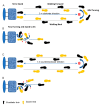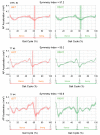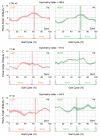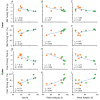Use of a Single Wearable Sensor to Evaluate the Effects of Gait and Pelvis Asymmetries on the Components of the Timed Up and Go Test, in Persons with Unilateral Lower Limb Amputation
- PMID: 35009638
- PMCID: PMC8747521
- DOI: 10.3390/s22010095
Use of a Single Wearable Sensor to Evaluate the Effects of Gait and Pelvis Asymmetries on the Components of the Timed Up and Go Test, in Persons with Unilateral Lower Limb Amputation
Abstract
The Timed Up and Go (TUG) test quantifies physical mobility by measuring the total performance time. In this study, we quantified the single TUG subcomponents and, for the first time, explored the effects of gait cycle and pelvis asymmetries on them. Transfemoral (TF) and transtibial (TT) amputees were compared with a control group. A single wearable inertial sensor, applied to the back, captured kinematic data from the body and pelvis during the 10-m walk test and the TUG test. From these data, two categories of symmetry indexes (SI) were computed: One SI captured the differences between the antero-posterior accelerations of the two sides during the gait cycle, while another set of SI quantified the symmetry over the three-dimensional pelvis motions. Moreover, the total time of the TUG test, the time of each subcomponent, and the velocity of the turning subcomponents were measured. Only the TF amputees showed significant reductions in each SI category when compared to the controls. During the TUG test, the TF group showed a longer duration and velocity reduction mainly over the turning subtasks. However, for all the amputees there were significant correlations between the level of asymmetries and the velocity during the turning tasks. Overall, gait cycle and pelvis asymmetries had a specific detrimental effect on the turning performance instead of on linear walking.
Keywords: kinematics; limb prosthesis; sensory–motor gait disorders; spatial–temporal analysis; symmetry index.
Conflict of interest statement
A.V. is an engineer belonging to BTS Bioengineering, which commercializes the inertial wearable sensor.
Figures






Similar articles
-
Upper body accelerations during level walking in transtibial amputees.Prosthet Orthot Int. 2019 Apr;43(2):204-212. doi: 10.1177/0309364618792745. Epub 2018 Aug 16. Prosthet Orthot Int. 2019. PMID: 30112983
-
Comparison of trauma and diabetes mellitus-induced transtibial amputees in terms of gait parameters and functional capacity.Ulus Travma Acil Cerrahi Derg. 2025 Mar;31(3):259-268. doi: 10.14744/tjtes.2024.83923. Ulus Travma Acil Cerrahi Derg. 2025. PMID: 40052320 Free PMC article.
-
Symmetry function - An effective tool for evaluating the gait symmetry of trans-femoral amputees.Gait Posture. 2021 Oct;90:9-15. doi: 10.1016/j.gaitpost.2021.07.021. Epub 2021 Aug 2. Gait Posture. 2021. PMID: 34358849
-
Influential factors in stability of lower-limb amputees.Am J Phys Med Rehabil. 2013 Dec;92(12):1110-8. doi: 10.1097/PHM.0b013e31829b4b7a. Am J Phys Med Rehabil. 2013. PMID: 23900009 Review.
-
Biofeedback Systems for Gait Rehabilitation of Individuals with Lower-Limb Amputation: A Systematic Review.Sensors (Basel). 2020 Mar 14;20(6):1628. doi: 10.3390/s20061628. Sensors (Basel). 2020. PMID: 32183338 Free PMC article.
Cited by
-
Gait asymmetrical evaluation of lower limb amputees using wearable inertial sensors.Heliyon. 2024 May 31;10(12):e32207. doi: 10.1016/j.heliyon.2024.e32207. eCollection 2024 Jun 30. Heliyon. 2024. PMID: 38975224 Free PMC article.
-
Wearables for Movement Analysis in Healthcare.Sensors (Basel). 2022 May 13;22(10):3720. doi: 10.3390/s22103720. Sensors (Basel). 2022. PMID: 35632128 Free PMC article.
-
Validity of Wearable Gait Analysis System for Measuring Lower-Limb Kinematics during Timed Up and Go Test.Sensors (Basel). 2024 Sep 29;24(19):6296. doi: 10.3390/s24196296. Sensors (Basel). 2024. PMID: 39409336 Free PMC article.
-
Kinesiological Analysis Using Inertial Sensor Systems: Methodological Framework and Clinical Applications in Pathological Gait.Sensors (Basel). 2025 Jul 16;25(14):4435. doi: 10.3390/s25144435. Sensors (Basel). 2025. PMID: 40732570 Free PMC article.
-
Identifying the Effects of Age and Speed on Whole-Body Gait Symmetry by Using a Single Wearable Sensor.Sensors (Basel). 2022 Jul 2;22(13):5001. doi: 10.3390/s22135001. Sensors (Basel). 2022. PMID: 35808494 Free PMC article.
References
MeSH terms
LinkOut - more resources
Full Text Sources
Medical
Miscellaneous

